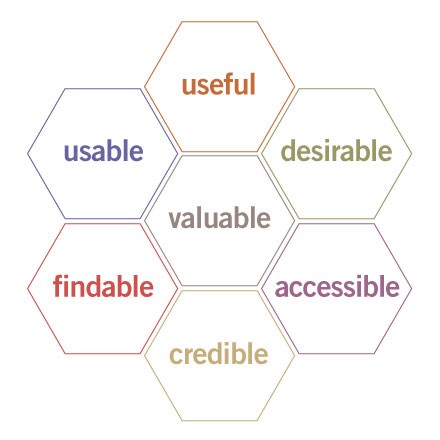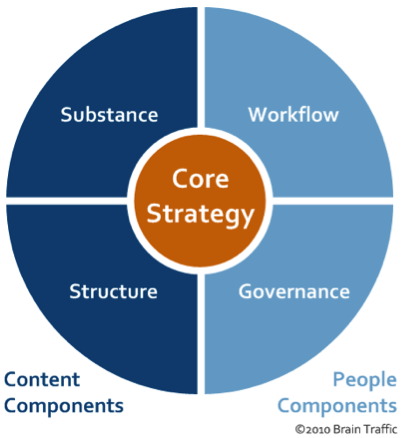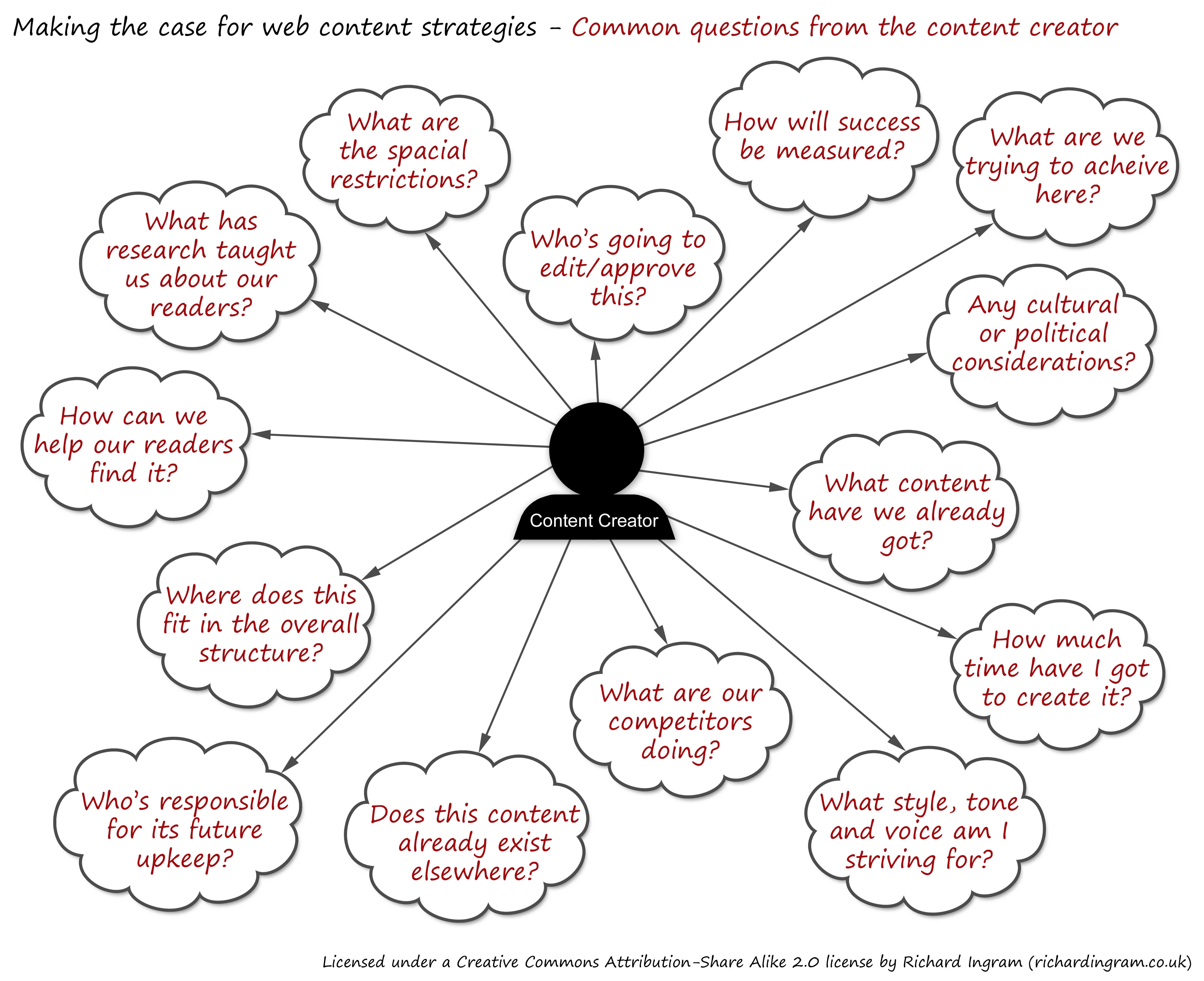Content strategy has been around for a long time. Large corporations such as Disney, Wells Fargo, and Mayo Clinic have had functional content strategy teams for years. The mega-agency Razorfish has had dedicated content strategists on staff since 1998. But it’s really only been in the last two years that the larger UX community has started paying closer attention to content strategy. In 2008, not a single UX conference had a session or workshop devoted to content strategy; In 2010, nearly all of them did, including the IA Summit, UX Week, UX London, User Interface Conference, and even SXSW.
Why the gold rush? The answer is pretty simple: it’s inherently impossible to design a great user experience for bad content. If you’re passionate about creating better user experiences, you can’t help but care about delivering useful, usable, engaging content.
No matter how brilliant your designs, if the content is bad, the honeycomb crumbles. (The User Experience Honeycomb – Peter Morville, 2004)
Today, the sudden surge of interest in content strategy has stirred hope in even the most jaded UX souls. Here’s an entire population of professionals who are ready and willing to tackle even the most complex content problems! But before UX and content strategy walk hand-in-hand off into the sunset, we should consider a little marriage counseling. Do these two really belong together?
What Exactly Is Content Strategy?
Content is consistently a huge problem in most project work, but we often don’t have the time or tools to figure out exactly where our process is broken. A content strategist sounds like just the sort of person to save the day, even if no one’s clear about what exactly that person will do. (I regularly get calls from companies who have hired content strategists and are now wondering what to do with them.)
For me, the easiest way to describe content strategy is this: content strategy plans for the creation, delivery, and governance of useful, usable content. I’ve been using that definition for a while now, and it seems to help people understand the concept pretty quickly. It certainly isn’t the only way to look at it, though; for an expanded discussion on the topic, visit the content strategy Google Knol.
Melissa Rach, Vice President of Content Strategy at Brain Traffic, developed this framework for content strategy:
Core strategy defines how your content will help you meet business objectives.
Substance identifies what content is required to successfully execute implement your core strategy, including characteristics such as messaging architecture, intended audience(s), and voice and tone.
Structure focuses on how content is prioritized, organized, and acessed. Although structure can include information architecture (IA), it focuses more deeply on the content itself, including mapping messages to content, content bridging, and creating detailed page tables.
Workflow explains how people manage and maintain content on a daily basis, including the roles, tasks, and tools required throughout the content lifecycle.
Governance describes the policies, standards, and guidelines that apply to content and its lifecycle, as well as how an organization will sustain and evolve its content strategy.
There are aspects of substance and structure that have traditionally been the domain of information architects, and that still holds true. As Louis Rosenfeld has said, “If [information architecture] is the spatial side of information, I see content strategy as the temporal side of the same coin.” Both must consider things such as current state content, taxonomies, content models, cross-platform requirements, and so on. But an IA is rarely responsible for editorial, workflow, or governance components of content planning and development. For UX teams, these are the areas that, when overlooked, tend to blow up project timelines and compromise content quality.
So, Is Content Strategy a Part of UX Strategy?
Technically? No, not really. While workflow and governance have direct impact on the end content product, they don’t (and can’t) live exclusively within the domain of UX. But substance, structure, workflow, and governance typically inform one another, which is where the content strategist can really make a difference. They can act as a UX advocates to content creators, while keeping designers in “the real world” when it comes to things like content requirements and template designs.
Maybe it’s easier to answer the question like this: not every content strategy needs UX strategy, and not every UX strategy needs content strategy. Yes, they’re both required for the effective execution of just about any initiative that requires or specifies the need for content creation, delivery, or management. But that doesn’t mean we need to cram content strategy into every UX project plan, because sometimes, it’s clearly unnecessary.
For example, a lightweight application redesign likely doesn’t require a content strategist, although it probably could benefit from a smart copywriter familiar with usability principles. On the flip side, a content strategy project that focuses largely on content workflow and governance likely won’t need to pull in a UX strategist, but might need a good interaction designer to assist with workflow documentation.
It follows, then, that a content strategist doesn’t always report to a UX strategist, and vice versa. On a large-scale project that involves a lot of complex content initiatives, a lead content strategist may oversee a larger team that includes UX practitioners. On a full website redesign, a UX strategist may lead a team that includes a content strategist who’s (either partially or fully) responsible for anything related to the creation, delivery, and governance of the site content.
A side note: do I really care about who owns what and where things fall on either side of the wall? Emphatically, no, I don’t; debates that smack of territorialism make me insane. Roles, activities, and artifacts shouldn’t “belong” to one discipline or another. What’s important is that we are all able to talk about shared principles; this is where the foundation for our collaboration truly lies. Pragmatically speaking, there are multiple interdependencies between those roles, activities, and artifacts of UX pros and content strategists. These interdependencies and commonalities demand that we work together to deliver the high quality content our users want and deserve.
How Does Content Strategy Relate to UX Design?
There are a few different ways to look at this. From a services perspective, a good description of the relationship is IBM’s “Customer Facing Solutions” infographic, published to demonstrate the consultancy’s UX strategy approach:
Erin Scime of HUGE created this sketch to demonstrate the content lifecycle. You’ll recognize several activities that are often included in UX projects, as well as several that aren’t:
Taking a closer look at project roles, Richard Ingram of Ingserv created this illustration to show ways in which a UX team might collaborate with a content strategist:
For a practical look at how content strategists contribute to a UX project, Erin Kissane’s article, What Do Content Strategists Do? offers a description of her typical project activities. Also, Karen McGrane’s stellar presentation, Why UX Needs Content Strategy, examines in detail the activities and deliverables a content strategist can contribute to a UX project.
Is Content Strategy Just the Latest Trend?
Sometimes in posts on Twitter or in blogs, I come across comments about content strategy like these: “I do all this stuff already. No way will my clients pay for any of this. Content strategy is just a trend. ‘Content strategist’ is just a title writers assume to get paid more money.”
I’m not sure what to tell people who get defensive when I talk about content strategy. Beautiful designs are constantly obliterated by bad content. Content delay syndrome is an epidemic. We all deal with nonstop complaints (sometimes our own!) about poor quality content on our website, intranet, or application. Content strategy solves these problems before they even begin. It isn’t a trend, and it’s not a silver bullet. It’s a long-term commitment to better content, a practice that beautifully complements the art and science of UX strategy.
What Else Should UX Professionals Know About Content Strategy?
Two years ago, there wasn’t much out there about content strategy. Today, there’s an ever-expanding treasure trove of insightful, forward-looking resources to refer to:
- Keep an eye out for the March 8 release of Erin Kissane’s brilliant The Elements of Content Strategy from A Book Apart.
- ‘Til then, make do with my book, Content Strategy for the Web.
- Read Andrew Maier’s Complete Beginner’s Guide to Content Strategy.
- Catch up on the conversation by reading Richard J. Ingram’s terrific recap of his favorite content strategy articles of 2010.
- Attend (or start) a local content strategy Meetup.
- Come to Confab, a content strategy conference hosted by Brain Traffic this May in Minneapolis.









